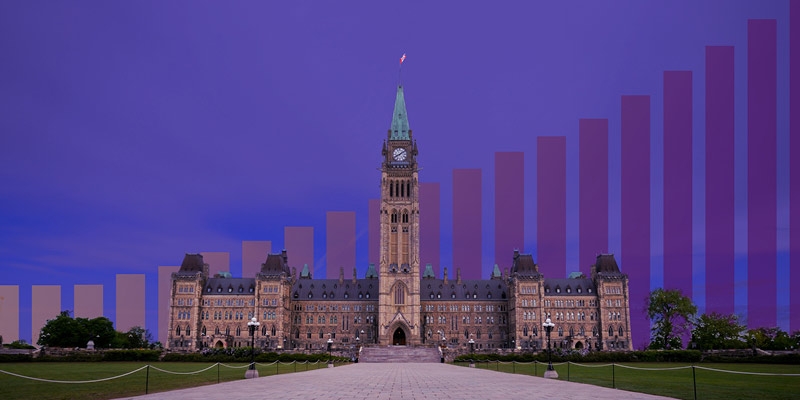Explaining the Growth in Federal Program Spending since 2015

In 2019, federal program spending reached $322.9 billion, an increase of $69.1 billion or 27.2% (nominal) since 2015. After adjusting for inflation, the increase in program spending is still sizeable at $50.2 billion or 18.4%. The government finances current spending through taxes, imposed either today—or tomorrow through borrowing. It is important that Canadians understand where these increased expenditures are being made. This analysis clarifies what areas of federal spending explain the overall increase observed between 2015 and 2019 (pre-recession).
In total, 34 categories of federal spending were analyzed across three main areas: (1) major transfers to persons (4 categories), major transfers to other levels of government (5 categories), and direct program expense (25 categories). Five spending categories explain nearly two-thirds (60.1%) of the growth in overall program spending from 2015 to 2019: Children’s Benefits, Elderly Benefits, National Defence, Indigenous and Northern Affairs, and the Canada Health Transfer.
- Children’s Benefits represented the largest share of the increase in federal program spending ($9.6 billion), accounting for 13.9% of the total increase in program spending.
- Elderly Benefits ($9.3 billion) ranked second in the share of the change in federal program spending at 13.4%.
- National Defence ($8.1 billion) ranked third and represented 11.8% of the total increase in program spending.
- This was followed closely by Indigenous and Northern Affairs ($8.1 billion), which represented 11.7% of the total increase in program spending.
- Finally, the Canada Health Transfer (CHT) ($6.5 billion) represented 9.3% of the total increase in spending since 2015.
It is worth noting the disproportionate contributions of some of these spending areas to the overall growth in program spending. For instance, despite accounting for just 5.6% of total spending in 2015, Children’s Benefits represented 13.9% of total program spending growth from 2015 to 2019. Similarly, Indigenous and Northern Affairs accounted for 4.5% of total spending in 2015 yet represented 11.7% of total growth in program spending.
The three other spending areas had roughly proportional growth. Elderly benefits contributed slightly more to total spending in 2015 (17.4%) than it did to total growth (13.4%) as did the Canada Health Transfer, which contributed 12.7% to total spending in 2015 but accounted for 9.3% of the overall growth in program spending. National Defence represented 9.4% of program spending in 2015 and accounted for 11.8% of total program spending growth.
It is also worthwhile to understand the nature of the increases in the five categories of spending. The increases observed in Children’s Benefits as well as Indigenous and Northern Affairs were largely, if not exclusively, discretionary policy decisions made by the government, while the increases in Elderly Benefits are largely automatic, driven by a growing population of seniors. Similarly, the increases in the Canada Health Transfer are determined by the existing formula rather than any particular discretionary decision. And finally, the increase in spending on National Defence may derive from Canada’s attempt to uphold its NATO commitments for spending as a share of the economy.
There is no doubt that Canada experienced a pronounced increase in federal program spending between 2015 and 2019, well before the recession. Equally clear but not well known is that five areas out of a total of 34 federal areas of spending, represent almost two-thirds of the total increase in spending observed over the period from 2015 to 2019.
Authors:
More from this study
Subscribe to the Fraser Institute
Get the latest news from the Fraser Institute on the latest research studies, news and events.





